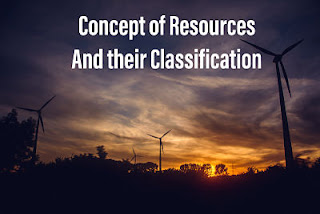Resources/Natural Resources are naturally occuring materials, that human beings at any state of economic development or technological awareness perceives to be required or useful for their utilisation.
Zimmerman accordingly said that:-
The world resources do not refer to a thing or a substance instead, it refers to a function, which the thing or a substance may perform.
Terms Related to Concept of Resources
Neutral
Resources which have no practical ability or utility on the basis of present technical knowledge is called as neutral stuff.
Examples:- Till 1895 petroleum was a neutral stuff.
Resistance
The process which comes in the way of effective utilisation of resources is called as resistance.
Examples:- Technical, economic and transportation processes.
Functional Concept Resources
Resource creation is a function of space and time, with increase in knowledge or requirement, functions of a resource may change over time or space (either diminishes or increases).
Example:- South Africa have abundant water resources but Japan utilise water the most because of it's high energy requirements.
Dynamic Concept of Resources
As we know that resource creation is a function of time hence it can also be said that resources are dynamic in nature. Whose resource utilisation changes, which makes them usable or non-usable.
Accordingly Hamilton said that:-
It is technology which gives value to the neutral, which it processes and convert them to useful resources.
Example- Solar Energy, Sea Waves etc.
Classification of Resources
Resources can be classified into various types on the basis of different aspects.
On the Basis of Origin
Biotic Resources
Resources which are obtained from biosphere and have life in any form is called as Biotic Resources .
Example - Forest, wildlife, livestock, and even Human beings.
Also Read: Economic Development and Models
Abiotic Resources
Resources which is obtained from nature but are not a living thing or have life in any form is called as abiotic resources.
Example:- Minerals, wind, solar radiation, sea waves, water etc.
On the Basis of Exhaustibility
Exhaustibility is one of the main aspects while assessing resources. On this basis,resources can be divided into two types:-
Renewable Resources
Resources which can eb renewed or reproduced and are almost permanent in nature is called as Renewable Resources.
Examples:- Solar Energy, Wind, water etc.
Non-Renewable Resources
Resources which are formed Geologically in a very long period of time are difficult to be renewed or reproduced is called as Non-Renewable or Exhaustible Resources.
Recyclable :- Metals (iron, copper, Aluminium)
Non-Recyclable - fossil fuels (Coal and petroleum)
On the Basis of State of Development
On the basis of the stage of development, resources can be classified in to 4 types:-
Potential Resources
Resources which have potential to satisfy human beings but are not utilised properly are called as potential resources
Examples:- Solar Energy has great potential in India's Rajasthan and gujarat but are not utilised efficiently yet.
Developed/Actual Resources
Resources which are assessed and their quality and quantity have been surveyed for utilisation with existing technological knowledge.
Stock
Resources which have potential to satisfy human needs but human beings do not have the appropriate technology to access these.
Examples:- Hydrogen, Thorium (in India).
Reserves
A subset of stock, it means those stocks which are yet to be put into use with existing technical 'know how' and reserved for future requirements.
On the Basis of Distribution
Resources on the basis distribution can be classified into two types:-
Ubiquitous Resources
resources which are abundantly found everywhere in the world is called as ubiquitous resources.
Example:- Wind.
Localised Resources
Resources which are not found everywhere and localised into some particular regions are called as regional resources.
Examples:- Minerals, petroleum etc.
On the Basis of Ownership
Resources, on the basis of ownership can be classified into four types:-
Private/Individual Resources
Resources which are owned by private person/individuals is termed as Private/Individual resources.
Examples:- Farm lands, houses, individual ponds, pasture lands, plantation.
Community Resources
Resources- that are owned by community, that means resources, which can be utilised by any individual of the community is called as community resources.
National Resources
Resources, which are not owned exclusively by individuals or community are called as National resources.
Examples:- Roads, railways, spectrum waves, minerals.
International Resources
Resources in the ocean found after exclusive Economic zone (beyond 200 Kms) of a country is known as international resources, which can be utilised only after consensus of international organisations.
Example:- Fishes, marine deposits etc.











